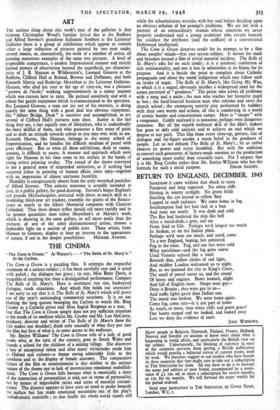THE CINEMA
The Corn is Green." At Warner's.—" The Bells of St. Mary's." At the Carlton.
The Corn is Green is a puzzling film. It attempts the respectful treatment of a serious subject ; it has been carefully cast and is acted with polish ; the dialogue has grace ; its star, Miss Bette Davis, is incapable of anything less than a distinguished performance. Compare The Bells of St. Mary's. Here is sentiment run riot, hackneyed dialogue, stock situations. And which film holds our attention? I am sorry to say that it is The Bells of St. Mary's which will prove one of the year's outstanding commercial successes. It is no use blaming the long queues besieging the Carlton to watch Mr. Bing Crosby as a Catholic priest and Miss Ingrid Bergman as a nun. I fear that The Corn is Green simply does not pay sufficient attention to the needs of its medium whilst Mr. Crosby and Mr. Leo McCarey, producer director and writer of The Bells of St. Mary's (how the title makes one shudder), think only secondly of what they put into the film but first of what is to come across to the audience.
Mr. Frnlyn Williams' The Corn is Green tells of a lady of good works who at the turn of the century, goes to South Wales and founds a school for the children of a mining village. She discovers a boy of exceptional talent and after many vicissitudes sends him to Oxford and culture—a theme owing admirably little to the novelette and to the display of female anatomy. The comparative failure of the film as entertainment is due neither to the serious nature of the theme nor to lack of meretricious emotional embellish- ment. The Corn is Green fails because what is essentially a story of the interaction of personalities is told, not in terms of personality, but by means of improbable twists and turns of material circum- stance. The director appears to have seen no need to probe beneath the surface but has made emotional mountains out of the play's melodramatic molehills ; so that finally the whole world stands still
while the schoolmistress wrestles with her soul before deciding upon an obvious solution of her protégé's problems. We are left with a portrait of an extraordinary woman whose emotions we never properly understand and a young coalminer who reveals beneath the coaldust the attributes (and the coiffure) of a conventional Hollywood intellectual.
The Corn is Green deserves credit for its attempt to be a film about peoples' minds—that rare screen subject. It misses the mark and becomes instead a film of trivial material incident. The Bells of St. Mary's asks for no such credit ; it is a synthetic confection of rich sentimentality, and one is lost in admiration at its fitness for its purpose. And it is beside the point to complain about Catholic propaganda and about the moral indigestion which may follow such an intake of sugar. The Bells of St. Mary's, like Going My Way, to which it is a sequel, obviously satisfies a widespread need for the screen portrayal of " goodness." The priest who solves all problems with a song and a smile ; the nun who teaches her favourite pupil to box ; the hard-hearted business man who reforms and saves the church school ; the extempore nativity play performed by toddlers with their own words and actions, all this is comforting in a world of atomic bombs and concentration camps. Here is " escape " with a vengeance. Coldly analysed it is nonsense, perhaps even dangerous nonsense. But all the superb technical skill of the film's makers has gone to defy cold analysis and to achieve an end which we despise at our peril. This film from every close-up, gesture, line of dialogue and lay-figure exudes a warm belief in the goodness of people. Let us not debunk The Bells of St. Mary's ; let us rather observe its power and retire humbled. But with the ambition to convert such generators of factory-made emotion to the production of something more useful than crocodile tears. For I suspect that it is Mr. Bing Crosby rather than Mr. Emlyn Williams who has the formula for such a social purpose. EDGAR ANSTEY.


























 Previous page
Previous page